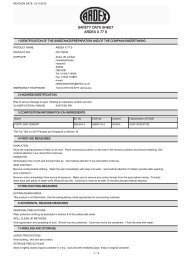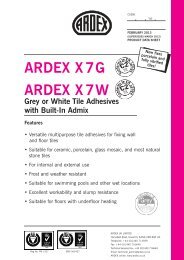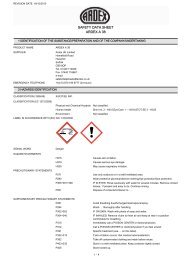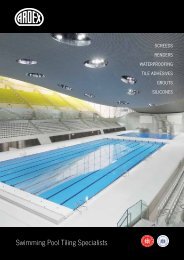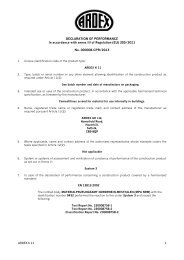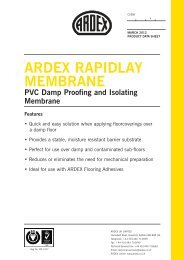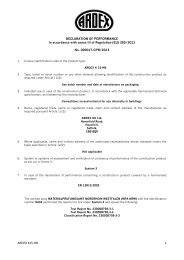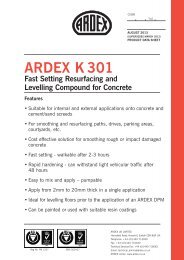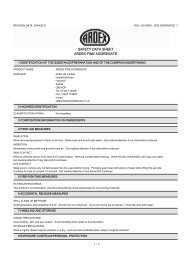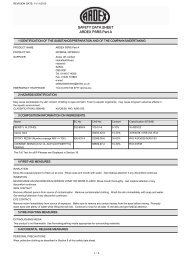You also want an ePaper? Increase the reach of your titles
YUMPU automatically turns print PDFs into web optimized ePapers that Google loves.
CI/SfB(43) Yq2MAY 2012(SUPERSEDES NOVEMBER 2011)PRODUCT DATA SHEET<strong>ARDEX</strong> A 23Rapid Hardening Cement forFloor ScreedsFeatures• Rapid hardening – walkable in 8 hours• Install ceramic tiles after 48 hours and natural stoneafter 72 hours• Install resilient and wood floor finishes after 6 days• Apply as a bonded, unbonded or floating screed• Can be used with underfloor heating systems• Can be pumped for fast applicationReg No. FM 1207 EMS 565427<strong>ARDEX</strong> <strong>UK</strong> LIMITEDHomefield Road, Haverhill, Suffolk CB9 8QP <strong>UK</strong>.Telephone: +44 (0)1440 714939Fax: +44 (0)1440 716640Technical Services Fax: +44 (0)1440 716663Email: technical.services@ardex.co.uk<strong>ARDEX</strong> online: www.ardex.co.uk
<strong>ARDEX</strong> A 23Rapid Hardening Cement for Floor ScreedsDESCRIPTION<strong>ARDEX</strong> A 23 is a special cement for producing arapid hardening floor screed for internal use whichallows ceramic tiles to be fixed after 48 hours,natural stone after 72 hours, and resilient floorcoverings after 6 days.USE<strong>ARDEX</strong> A 23 is used to produce bonded, unbondedand floating screeds in internal locations whereearly foot traffic is required and where rapid dryingis essential, e.g. to allow ceramic/porcelain tiles tobe laid after 48 hours.A 1:7 mix is suitable for most normal screedingsituations.<strong>ARDEX</strong> A 23 can be installed on ground supportedconcrete slabs if an effective damp proof membrane ispresent. <strong>ARDEX</strong> A 23 is not suitable as a wearing surface.THICKNESS<strong>ARDEX</strong> A 23 should be applied at the conventionalthicknesses for normal cement/sand screeds i.e.Minimum 20mm, (design thickness up to 40mm)for bonded screeds.Minimum 50mm for unbonded screeds.Minimum 75mm for floating screeds.65mm in lightly loaded (domestic) locations.SUBSTRATE PREPARATIONBonded ScreedThe <strong>ARDEX</strong> A 23 cement and sand screed can belaid as a bonded screed by applying <strong>ARDEX</strong> A 23grouting slurry to a dry and suitably preparedconcrete base. If the concrete is not dry, 2 coatsof <strong>ARDEX</strong> DPM may be used prior to applying the<strong>ARDEX</strong> A 23 screed ‘fresh in fresh’ in a priminglayer of <strong>ARDEX</strong> R 3 E or a third coat of <strong>ARDEX</strong> DPM.To prepare the grouting slurry dilute <strong>ARDEX</strong> P 51with an equal volume of water. Mix the <strong>ARDEX</strong> A 23cement with the diluted bonding agent to produce acreamy consistency grouting slurry.The <strong>ARDEX</strong> A 23 cement and sand screed mortarmust be compacted onto the base ‘fresh in fresh’,whilst the grouting slurry is still wet and workable.Unbonded ScreedFor unbonded screeds it is good practice to ensurethat the concrete slab surface is reasonably true andflat prior to applying a separating layer or dampproof membrane. An unbonded <strong>ARDEX</strong> A 23 screedcan receive ceramic or porcelain tiling after 48 hours.Floating ScreedFor floating screeds, place a suitable separating layeror damp proof membrane over the insulation beforeapplying the screed mortar.MIX PROPORTIONSMaximum 1 part by weight of <strong>ARDEX</strong> A 23 screedingcement to 7 parts by weight screeding sand.The sand used should be good quality, well graded0/8mm sand. BS 8204-1:2003 recommends thatscreeding sands are classified to BS EN 13139.Alternatively a 0/8mm fine aggregate with finescategory 1 with range MP should be used.Experience has shown that sand complying withthe following grading table provides a workablescreeding mortar with good compactability.Sieve size (BS 410) Proportion by dry masspassing nominal mesh size.10.00mm 100%5.00mm 90% – 100%2.36mm 65% – 97%1.18mm 40% – 90%600µm 24% – 75%300µm 8% – 40%150µm 0% – 10%75µm 0% – 3%Where the available screeding sand is good quality,but does not have the required coarse fraction, anominal 6mm aggregate can be mixed with thescreeding sand. The ratio of screeding sand to 6mmaggregate will depend upon the actual gradingsinvolved and the workability of the mix. For example;a mix of 1 x 20kg bag of <strong>ARDEX</strong> A 23 with 2 x 25kgbags of nominal 6mm aggregate and 3 x 25kg bagsof screeding sand.Total mix water, including the water contained inthe sand/aggregate should typically range from anoptimum of 9 litres up to a maximum of 11 litresper 20kg bag of <strong>ARDEX</strong> A 23.Where the screed thickness is consistently greaterthan 50mm, a fine concrete mix can be used bypartially replacing some of the screeding sand witha suitable amount of 8mm or 10mm single sizedaggregate. The optimum proportions of cement tosand, or to sand plus aggregate, should be determinedwithin the mix proportions of 1 part <strong>ARDEX</strong> A 23cement with 7 parts by weight of sand, or sand plusaggregate, in order to obtain good workability andachieve the required soundness category.The sand, fine or coarse aggregates used shouldnot contain lime or other materials that could bedetrimental to the workability of the screed mortarduring application, or the performance of the setand hardened screed. Do not add any other cementor lime materials to <strong>ARDEX</strong> A 23 mixes.MIXINGMix to a normal screed mortar consistency.If a mixer is used it should be of a pan, trough orother forced action type. Normal ‘free-fall’ mixersare not suitable for mixing semi-dry screed mortars.Use clean equipment and do not use other cements,lime or screed additives etc., in the mix.WATER CONTENTAdd sufficient water to obtain a workable mix.With an evenly graded, fairly dry sand, the waterrequirement will normally be about 10 litres per20kg bag of <strong>ARDEX</strong> A 23. When a sample of mortaris squeezed in the hand the sample should retain itsshape and not crumble, the hand being left slightlymoist. When a sample is compacted on the base,no film of water should form on the surface.To achieve rapid drying and strength development,as stated, not more than 11 litres should be added(including the water contained in the sand) per 20kgbag of <strong>ARDEX</strong> A 23 cement.APPLICATIONThe working time of the mixed mortar is approximately30 minutes at 20°C, therefore mixing, placing,compaction and trowelling off must proceed withoutdelay. The amount of mortar mixed and the area to bescreeded should be limited so that trowelling off andfinishing can be completed within the working time.Where a new bay is laid against a set and hardenedscreed it is recommended that such daywork jointsare vertical and treated with the grouting slurry andmay be tied together with steel reinforcement.Apply <strong>ARDEX</strong> A 23 cement and sand mortar attemperatures at 5°C and rising.Application on a floor heating system:When an <strong>ARDEX</strong> A 23 screed has been laid on ahot water floor system, 6 days should be allowed toelapse before heating up the screed to a temperatureof 25°C and maintained for a further 3 days.The maximum floor temperature should then beused and maintained for a further 4 days. In doingso draughts must be avoided. The floor should thenbe allowed to cool down to room temperature(above 15°C) before laying floorcoverings.SURFACE FINISHFor fixing ceramic tiles and quarry tiles, etc., the screedshould be finished with a wood float. Prior to layingthin floorcoverings e.g. vinyl sheet, a very smoothsurface may be obtained by priming the <strong>ARDEX</strong> A 23with <strong>ARDEX</strong> P 51 and applying <strong>ARDEX</strong> K 11 or<strong>ARDEX</strong> K 15 NEW Sub-Floor Levelling and SmoothingCompounds. If a primer free installation is requiredthen use ARDITEX NA.NOTE: Screeds are not designed as wearing surfacesand the screed surface should be given adequateprotection once dry, against damage water ingress,wear and contamination during subsequent buildingoperations. Protective coverings will also minimiseany curling and lipping at joints in unbonded screeds.PUMPINGIt is possible to pump <strong>ARDEX</strong> A 23 screed mixesusing a proprietary screed pump. Contact ourTechnical Services Department for further details.COVERAGEApproximately 0.27kg <strong>ARDEX</strong> A 23 cement per m 2for each millimetre of screed thickness using a 1:7mix. For slurry bonding allow an extra 2 x 20kg<strong>ARDEX</strong> <strong>A23</strong> cement and 4 x 5kg of bonding agent<strong>ARDEX</strong> P 51 per 100 square metres.PACKAGING<strong>ARDEX</strong> A 23 is packed in paper sacks incorporatinga polyethylene liner – net weight 20kg.STORAGE AND SHELF LIFEThis product must be stored in unopened packaging,clear of the ground in cool dry conditions and beprotected from excessive draught. If stored correctly,as detailed above, the shelf life of this product is 12months from the date shown on the packaging.PRECAUTIONS<strong>ARDEX</strong> A 23 contains Portland cement and, thereforein line with current legislation, is classified as irritatingto eyes and skin. For this reason the followingprecautions should be observed; Avoid contact withskin and eyes; in case of contact with the eyes rinseimmediately with plenty of water and seek medicaladvice; wear suitable gloves and keep the productout of reach of children. Avoid generation of airbornedust during mixing. For further information consultthe relevant health and safety data sheet.TECHNICAL DATAWeight of fresh mortar approx. 2kg/litreWorking time at 20°C approx. 30 minutesInitial Set (Vicat) at 20°C approx. 70 minutesFinal Set (Vicat) at 20°C approx. 130 minutesCompressive strength using 0-8mm graded aggregateand cured under conditions according to a version ofEN 13892.7 days 21N/mm 228 days 30.0 N/mm 2Drying TimeAfter 48 hours suitable to receive ceramic tiles tobonded, unbonded and floating screeds. After 6 dayssuitable to receive resilient floorcoverings and woodfloors.The time taken to harden, and the drying timeof the <strong>ARDEX</strong> <strong>A23</strong> cement, is determined by screedthickness and ambient conditions on site.Low temperatures will slow down the rate ofhardening whilst high temperatures will acceleratehardening, thus reducing the working time.NOTE: High or low relative humidity will slow oraccelerate the drying time respectively.Drying times apply to 23°C and 50% relative humidityfor screeds up to 50mm thick. The use of a Speedymoisture tester is recommended to determine themoisture content prior to applying the appropriatefloorcovering.For rapid drying screeds that dry uniformly, irrespectiveof thickness, consult the <strong>ARDEX</strong> A 38 or <strong>ARDEX</strong> A 35data sheets. Where higher early and late strengthdevelopment is required, a 1:5 mix may be used.Note the maximum mix water content that shouldbe used, including the moisture in the aggregate, is10.5 litres per 20kg bag of <strong>ARDEX</strong> A 23 cement forfloor screeds.Soundness (BRE Screed Test)Annex D and E of BS 8204-1:2003 contains adviceon the use of this in situ crushing resistance test onbonded, unbonded and floating screeds.The installed <strong>ARDEX</strong> A 23 can normally be testedafter 24 hours using the BRE screed tester, if required.The depth of an indentation of a correctly mixedand compacted screed should comply with therequirements of the floor finish and category of use.Moisture testing of <strong>ARDEX</strong> <strong>A23</strong> cement/sand screed.Should the moisture content need to be determined theSpeedy Moisture Tester (Carbide method) must be used.Please consult <strong>ARDEX</strong> Technical Services for furtheradvice. The following British Standard Codes of Practicecan be referred to for advice on screeding:-BS 8204: Part 1.In situ Floorings – Bases and ScreedsBS 5385: Part 3. Appendix C.Ceramic Floor Tiling and MosaicsBS 8000: Part 9.Code of Practice for cement/sand floor screeds andconcrete floor toppings (Workmanship on building sites).NOTE: The information supplied in our literature or given by our employeesis based upon extensive experience and, together with that supplied by ouragents or distributors, is given in good faith in order to help you. Our Companypolicy is one of continuous Research and Development; we therefore reservethe right to update this information at any time without prior notice. We alsoguarantee the consistent high quality of our products; however, as we have nocontrol over site conditions or the execution of the work, we accept no liabilityfor any loss or damage which may arise as a result thereof.Country specific recommendations, depending on local standards, codes ofpractice, building regulations or industry guidelines, may affect specificinstallation recommendations.TECHNICAL ADVICE HELPLINE:01440 714939<strong>ARDEX</strong> online: www.ardex.co.uk



